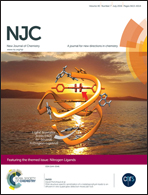A new rosamine-based fluorescent chemodosimeter for hydrogen sulfide and its bioimaging in live cells†
Abstract
A new probe (RosN3), which displayed excellent selectivity to H2S in mixed aqueous media, was synthesized. This method employed the H2S-mediated reduction of azides to amines, resulting in fluorescence quenching. The probe exhibited high H2S selectivity over other common anions and biothiols. The detection limit was measured to be 0.25 μM. Furthermore, the live cell imaging results demonstrated its potential for practical application in biological systems.


 Please wait while we load your content...
Please wait while we load your content...